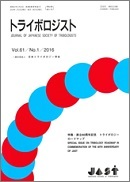Volume 58, Issue 2
Special Issue on Science of Friction: Towards Realization of Society with Carbon Minimum
Displaying 1-16 of 16 articles from this issue
- |<
- <
- 1
- >
- >|
Announcement
-
2013 Volume 58 Issue 2 Pages K2
Published: February 15, 2013
Released on J-STAGE: January 30, 2019
Download PDF (380K)
Contents
-
2013 Volume 58 Issue 2 Pages M2
Published: February 15, 2013
Released on J-STAGE: January 30, 2019
Download PDF (206K)
Serial Messages to Tribologists
-
2013 Volume 58 Issue 2 Pages 55
Published: February 15, 2013
Released on J-STAGE: January 30, 2019
Download PDF (635K)
Special Issue on Science of Friction: Towards Realization of Society with Carbon Minimum
-
2013 Volume 58 Issue 2 Pages 56
Published: February 15, 2013
Released on J-STAGE: January 30, 2019
Download PDF (668K)
Explanation
-
2013 Volume 58 Issue 2 Pages 57-64
Published: February 15, 2013
Released on J-STAGE: January 30, 2019
Download PDF (1213K) -
2013 Volume 58 Issue 2 Pages 65-70
Published: February 15, 2013
Released on J-STAGE: January 30, 2019
Download PDF (952K) -
2013 Volume 58 Issue 2 Pages 71-76
Published: February 15, 2013
Released on J-STAGE: January 30, 2019
Download PDF (1023K) -
2013 Volume 58 Issue 2 Pages 77-84
Published: February 15, 2013
Released on J-STAGE: January 30, 2019
Download PDF (2610K) -
2013 Volume 58 Issue 2 Pages 85-90
Published: February 15, 2013
Released on J-STAGE: January 30, 2019
Download PDF (2302K) -
2013 Volume 58 Issue 2 Pages 91-96
Published: February 15, 2013
Released on J-STAGE: January 30, 2019
Download PDF (1281K)
Essay The Tribo-Soshi, Essays from Tribologists
-
2013 Volume 58 Issue 2 Pages 97-101
Published: February 15, 2013
Released on J-STAGE: January 30, 2019
Download PDF (816K)
Original Contribution
-
2013 Volume 58 Issue 2 Pages 102-108
Published: February 15, 2013
Released on J-STAGE: January 30, 2019
Download PDF (1337K) -
2013 Volume 58 Issue 2 Pages 109-119
Published: February 15, 2013
Released on J-STAGE: January 30, 2019
Download PDF (1572K)
Short Paper
-
2013 Volume 58 Issue 2 Pages 120-124
Published: February 15, 2013
Released on J-STAGE: January 30, 2019
Download PDF (1710K)
Report of the Society
-
2013 Volume 58 Issue 2 Pages 125-129
Published: February 15, 2013
Released on J-STAGE: January 30, 2019
Download PDF (1242K) -
2013 Volume 58 Issue 2 Pages 128
Published: February 15, 2013
Released on J-STAGE: January 30, 2019
Download PDF (105K)
- |<
- <
- 1
- >
- >|
